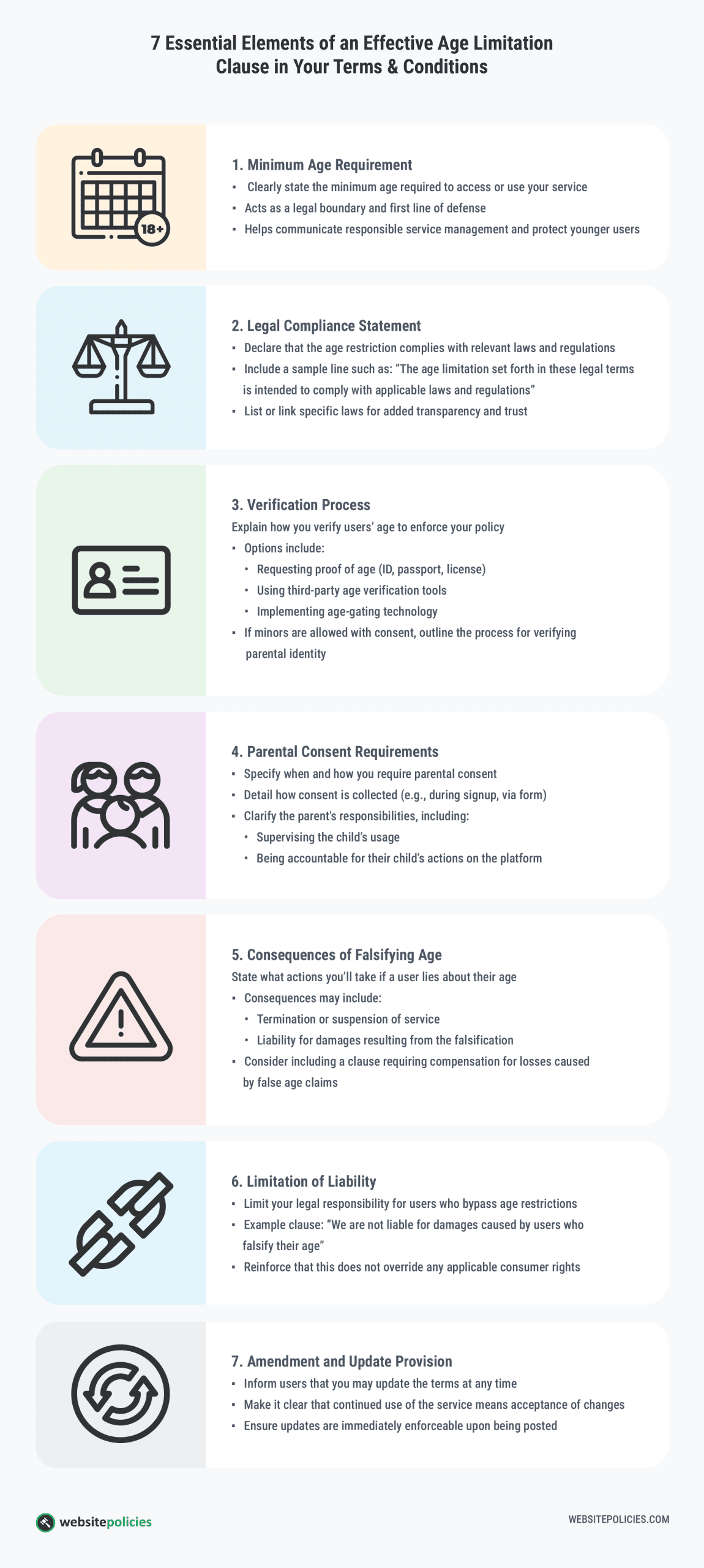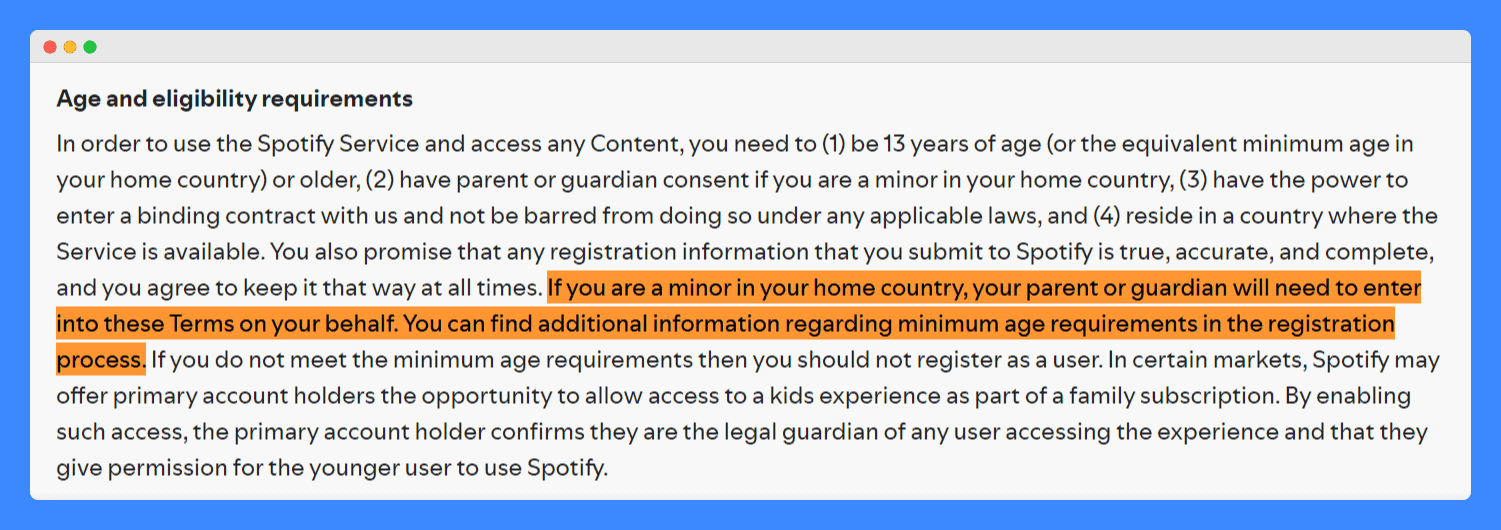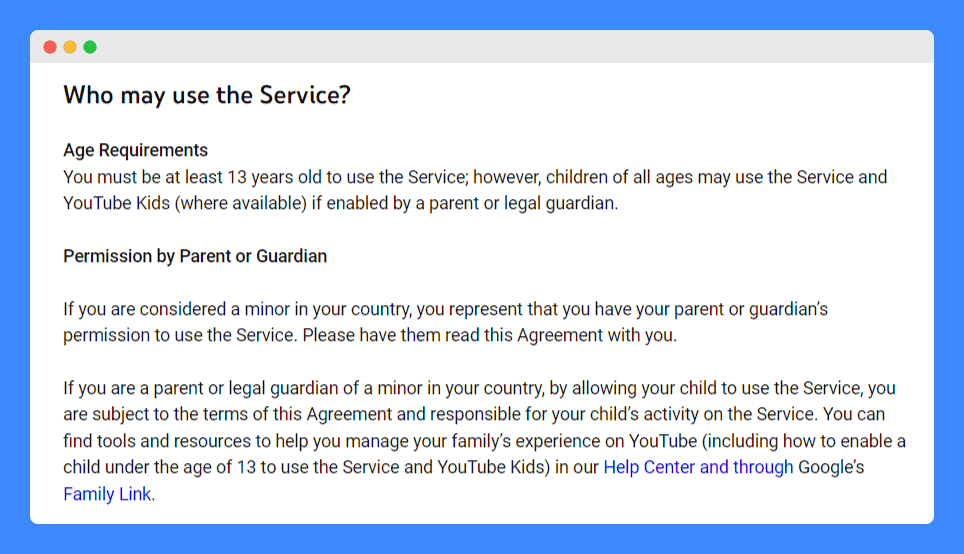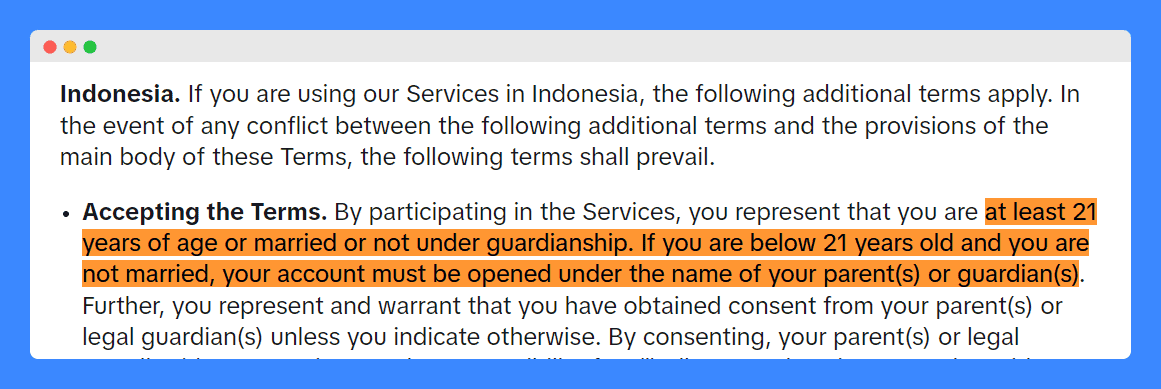A terms and conditions age limitation clause specifies the minimum age required for users to use your services legally and safely.
Without this clause, you might inadvertently allow minors to engage in contracts or activities they are not legally old enough to consent to, which can lead to potential legal disputes and liabilities.
But the question remains: Do you need an age limitation clause for your business?
Identifying your user base and understanding legal requirements will help determine whether you need this clause in your T&C.
To help with that, the upcoming sections will provide a detailed breakdown of when and why an age limitation clause becomes critical, the key components you should include, and practical tips on drafting one effectively.
- A terms and conditions age limitation clause helps prevent underage access and protects your business from liability.
- Consider your target audience and the specific risks associated with your platform when determining the appropriate minimum age.
- Regularly review and update your terms and conditions, including the age limitation clause, to ensure it remains effective and compliant with relevant laws.
Table of Contents
PRO TIP: Take the hassle of writing your own terms and conditions away with our terms and conditions generator trusted by over 200,000 businesses. It’ll save you hours of work and possible costly legal mistakes.
Why Should You Have an Age Limitation Clause for Your Terms and Conditions?
You should have an age limitation clause in your T&C because it clarifies who has the right to use your service. It also helps ensure that the access and use of the service meets the legal age requirements.
In other words, you need this clause:
To Comply with Legal Standards
Incorporating an age limitation clause is often a legal requirement for online businesses, especially those dealing with age-sensitive content or products such as alcohol or tobacco.
To further illustrate the importance of legal compliance, consider Louisiana House Bill 142. This bill mandates strict age verification for users accessing adult content, requiring government-issued IDs to ensure no minors can access harmful material.
Similarly, Texas House Bill 18 requires digital service providers to verify users’ ages and obtain parental consent for minors. This bill helps enforce strong parental controls to protect young users online.
Failure to adhere to these federal regulations, as well as local laws, can lead to hefty fines, significant damage to your business’s reputation, and even legal action.
To Facilitate Parental Consent
By setting an age limit, you reserve the right to request parental consent for underage users. Not only is this crucial for legal and ethical reasons, but it also helps manage how minors interact with your service.
For example, if your service is intended for teenagers and younger, you might require parental consent. This is important in light of the Children’s Online Privacy Protection Act (COPPA), a U.S. federal law that protects the privacy of children under 13.
Parental oversight is especially important in today’s digital age. In fact, a 2024 survey revealed that 62 percent of children in the U.S. have their own smartphone.
With so many children accessing services through personal devices, requesting parental consent helps parents or guardians be aware of their child’s online activities.
To Protect Against Third-Party Claims
Clearly stating who can legally use your services reduces the risk of facing claims from third parties regarding unauthorized use by minors.
This is particularly important for online business owners who operate in sectors where content or services are age-sensitive, such as e-commerce stores selling age-restricted products or digital platforms offering adult content.
A robust age limitation clause assures parents, guardians, and other stakeholders that your business takes responsible measures to prevent underage access.
To Define User Eligibility
Specifying a minimum age helps ensure that users who register are capable of understanding and agreeing to your specific terms. This is vital for enforcing contracts and maintaining a suitable user base.
For example, if your platform involves complex financial transactions, you might want to set a higher age limit to ensure that users have the necessary maturity and understanding to make informed decisions.
PRO TIP: Use a tiered age verification system for more sensitive activities. This tool requires additional proof of age beyond basic registration.
7 Key Components of Terms and Conditions Age Limitation Clause
To effectively protect your business and its users, your age limitation clause should include the following key elements:

1. Minimum Age Requirement
To set the stage for who can legally access or use the service, this section is where you specify the lowest age at which users are permitted to engage with your service or content.
Adidas provides a practical example of how businesses can implement a Minimum Age Requirement in their Terms and Conditions page:

Essentially, it’s the company’s first line of defense in enforcing the site’s terms and policies and ensuring the service operates within the bounds of the law.
When you clearly state that individuals below a certain age may not use the platform, you set transparent conditions of use. Personally, I see it as a way to demonstrate my site’s commitment to responsible service management.
2. Legal Compliance Statement
This statement explicitly acknowledges the governing law that mandates the age restriction. For example, you could say,
“The age limitation set forth in these legal terms is intended to comply with applicable laws and regulations. To the extent permitted by applicable law or regulation, individuals under the minimum age requirement may not access or use the service.”
In my experience, I find it beneficial to also list and link to the specific laws that may apply. This not only reinforces the transparency and credibility of your terms but also helps users understand the legal basis for these restrictions more clearly.
For example, for services accessible in the EU, mentioning compliance with the General Data Protection Regulation (GDPR) as it relates to age verification and linking to the relevant text could enhance user trust and comprehension.
3. Verification Process
This component outlines the methods you use to ensure that users meet the minimum age requirement. This could involve:
- Collecting proof of age: Requesting users to provide a copy of their birth certificate, driver’s license, or passport.
- Using third-party verification services: Partnering with age verification companies to verify users’ ages.
- Implementing age-gating technology: Using software or source code to restrict access to your service or content based on a user’s age.
If you require parental consent for minors to use your services, you may need to verify the identity of the person or entity who will act on behalf of the minor. This could involve requesting proof of guardianship or parental consent documents.
4. Parental Consent Requirements
If your age limitation clause requires parental consent for minors to use your services, this section should outline the process for obtaining that consent.
This is particularly crucial when your platform is accessible to minors who meet the minimum age requirement but are not yet of legal age to consent to the additional terms and conditions of your service on their own.
Consider if consent should be obtained directly or indirectly (such as through a registration process) from the parent or legal guardian, like in Spotify’s Terms of Use agreement:

I also recommend outlining the parent’s responsibilities and rights. For example, you might require parents to agree to supervise their child’s use of your services and to be responsible for any actions taken by their child.
5. Consequences of Falsifying Age
This part of your clause outlines the penalties or actions your platform will take if a user falsely declares their age. Adding this bit not only deters minors from accessing inappropriate content but also protects your platform legally.
Aside from saying that the product or service may be suspended or terminated, it’s important that users are advised of the possibility of such damages.
For example, you can say that they will be held responsible for any damage of any kind incurred as a result of their falsification.
PRO TIP: To strengthen your legal standing, go beyond standard warnings. Require users to compensate the platform or third parties for any losses caused by their falsified information.
6. Limitation of Liability
This component helps minimize the legal risks associated with the unauthorized use of your service by minors who may falsify their age. Here’s how you may word this:
“We expressly disclaim all warranties, express or implied, including the implied warranties of merchantability and fitness for a particular purpose. While we take reasonable steps to prevent underage access through strict age verification processes, we are not responsible or liable for any damages or claims that may result from unauthorized use by minors who falsely declare their age. Furthermore, our warranties or limitations on applicable statutory rights are not affected by these disclaimers.”
By including such a disclaimer, you clarify that while your business takes all necessary precautions to verify age and ensure compliance, it cannot be held accountable for instances where users circumvent these measures through deception.
7. Amendment and Update Provision
Here is where you clarify that your company may make changes to these terms at any time. Users must then agree to these terms to continue accessing the service and acknowledge that any updates take full force and effect immediately upon being posted.
Doing these guarantees that the amended terms are considered part of the entire agreement between the user and the service.
PRO TIP: Set a notification system to inform users of updates, so they can review the changes. To reinforce compliance, require them to actively acknowledge the new terms with a checkbox.
How To Write an Age Limitation Clause for Terms and Conditions
To comply with legal requirements and protect your platform from liabilities, follow these steps to write an age limitation clause for your T&C:
Step 1: Determine the Applicable Minimum Age
Start by researching the legal requirements in your jurisdiction as well as any international laws that might apply if your service is accessible globally.
Additionally, you can look at the practices of similar companies in your industry. Observing how they handle age restrictions can provide insights and help you set a benchmark for your own policies.
Step 2: Draft Your Terms and Conditions Agreement
Create a terms and conditions agreement for your online platform. This document will outline the rules and regulations governing your users’ access to and use of your services. You can use our free terms and conditions template for this.
This template has pre-written clauses you can customize to your business’s needs. Simply adjust the language to specify the minimum age requirement and the process for verifying user ages.
For a more tailored approach, use our free terms and conditions generator. By answering questions about your business, this tool can help you draft a comprehensive T&C that includes an age limitation clause.
Step 3: Communicate Changes and Updates
Inform users about any updates or changes to your terms, especially those related to age limitations.
You can do this by updating your platform’s FAQ or help sections to reflect these changes and provide additional guidance on how users can comply with these terms.
PRO TIP: Review and update your terms from time to time. Always encourage your users to read the terms thoroughly and agree to the terms before using your platform.
Examples of Terms and Conditions Age Limitation Clause
To help you understand how an age limitation clause can be implemented in your terms and conditions, here are some examples from popular online platforms:
1. YouTube
YouTube serves a vast, globally diverse audience that includes a significant number of minors. As such, it’s important that its Terms of Service includes a clause regarding age limitation:

YouTube is essentially saying, “For minors to use our services, they must have permission from a parent or guardian.” This ensures that minors are consuming content that is appropriate for their age and that parents are involved in that decision
Additionally, it helps the platform create a respectful environment where intellectual property rights are honored and protected.
With this clause, YouTube can better enforce its rules against copyright infringement and maintain the integrity of the content hosted on the platform.
2. Samsung
Samsung’s age limitation clause provides a strategic model for online business owners looking to ensure that their platforms are both accessible and legally compliant.
The distinction it makes between general access to the site and participation in specific activities, like entering a contest or joining a club, offers a clear framework for how to structure similar limitations.

As a business owner, mimicking this approach means you can cater to a broader audience while maintaining stringent controls where needed.
You can allow everyone to access the service but restrict participation in specific sections or activities to users who meet additional criteria, such as being over a certain age or having parental consent.
3. TikTok
With the growing concerns about children using platforms like TikTok, the platform’s age limitation clause is particularly important.
To address these concerns, TikTok set a minimum age of 13 years old. This demonstrates its commitment to responsible online practices and ensures that its platform is used in a safe and appropriate manner.

Additionally, the clause specifies that the age limit may vary depending on applicable local laws and regulations. For example, TikTok has implemented a stricter age requirement in Indonesia:

This means that the age limit can be higher or lower than 13, except to the extent permitted by law of the country. This allows TikTok to comply with different age restrictions in different countries, while still protecting minors.
4. Humane, Inc.
In the case of Humane, Inc., setting a clear threshold of 16 years ensures that users of the service are mature enough to understand and abide by the terms of use.
This is crucial for services that might involve complex user interactions or financial transactions.

What’s more, by requiring users under 18 to obtain parental consent, Humane, Inc. ensures legal protection and reduces potential liabilities associated with underage users.
5. Zoom
Zoom’s age limitation clause is another great example for online business owners. By stating that users must be of legal age to form contracts, Zoom ensures they meet legal obligations and avoid complications with underage users.
This is key for any service that handles personal data or engages in communications where legal maturity is required.

That said, for younger users under sixteen, Zoom makes an exception only for educational purposes under strict conditions. This shows a controlled way to expand the user base while maintaining safety.
Frequently Asked Questions
Can my business face legal issues if minors agree to my terms?
Yes, your business can face legal issues if minors agree to your terms. Contracts with minors are often unenforceable, exposing your business to legal risks.
Which industries should have an age limitation clause in terms and conditions?
Industries like e-commerce, gaming, social media, streaming services, and those selling age-restricted products (alcohol, tobacco, etc.) should have an age limitation clause to comply with laws and protect minors.
Can I be held liable if a user lies about their age when agreeing to my terms and conditions?
You may not be held liable if a user lies about their age, as long as you have taken steps to verify age and included disclaimers. However, this depends on local laws and your platform’s policies.
How do I update my terms and conditions to include or modify age restrictions effectively?
To update your terms and conditions, use our template or generator to modify or add age restrictions. This ensures your terms are comprehensive, up-to-date, and compliant with legal requirements.
How often should I review my age-related terms?
Review your age-related terms at least annually or whenever there are legal changes in your industry.



